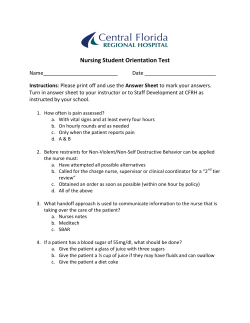
Sabina Raducan
Sabina Raducan1,2 ( 1Summer Placement Student at HR Wallingford, 2University of Kent, 3rd Year MPhys Student) Introduction The aim of this project was to validate numerical model results obtained using the sediment transport module of the CFD model REEF3D. The model output was validated against experimental data from published papers and internal studies conducted at HR Wallingford. REEF3D is an open-source CFD code, written in highly modular C++. The model was developed by Dr Hans Bihs from the Norwegian University of Science and Technology, Trondheim. This code uses the continuity and the incompressible Reynolds-averaged Navier-Stokes (RANS) equations as the governing equations for mass and momentum conservation. The flow is solved as a two phase flow problem. REEF3D is able to simulate complex motions of the air water interface, using the level set method. Sediment transport is calculated using well known sediment concentration and bed load transport formulae. Two dimensional simulations In the first study, a twodimensional numerical model was established in order to simulate the development of scour around an offshore pipeline, under the influence of unidirectional steady currents. Different aspects of the simulation were compared with results from the literature. agreement with findings from previous studies. Figure 1. Instantaneous streamlines of vortex formation at t=2 s. In the model results a vortex was observed immediately downstream of the pipeline. This behaviour was in The pressure magnitude was also investigated, being within the range of the theoretical value. Under this flow regime sediment transport is expected to occur as bed load only. Although the model predicted the qualitative behaviour of the bed reasonably well quantitative comparisons of model results and experimental data were poor. Scour validation tests Scour around contractions The second study simulated 3D scour and deposition patterns for steady flow around a rectangular abutment. The computational domain was set 3 m long, 1.2 m wide and 0.4 m high. The sediment used was fine uniform sand. The numerical results were compared with the lab data obtained at HR Wallingford’s Froude Modelling Hall. It was observed that the simulation gave accurate predictions of the scour development, with only minor differences in terms of deposition. Figure 2. Hydrostatic pressure when the water level is h=0.35 m. For the third study, a 3D simulation was set up in order to reproduce a series of tests conducted at the University of Basilicata in Italy. Figure 3.Photograph of one of the structures used in Test no. 3 The tests were simulating the development of scour around contractions in a rectangular flume. The computational domain was 16 m long, 1 m wide Figure 6. Morphological bed change at the end of the simulation and 0.35 m high. The sediment used was coarse sand with median a grain diameter (d50) of 1.7 mm. After initial calibration good results were obtained. Due to the very large domain sizes, the running time of the simulation was very long (about two weeks) which represented a major problem in testing different parameters. Figure 4. Simulated bed profile and measured bed profile at after t=49.3 hours, along a 2D transect Figure 5. 3D simulation of the morphological bed change, showing the deposition and the scour developed around a rectangular abutment Figure 7. Experimental flume during the test, at University of Basilicata Figure 8. Bed profile after a simulated time of t=8 hours, along a 2D transect through the middle of the domain Conclusions We conclude that the REEF3D code appears to be a promising tool for the simulation of sediment transport under both steady and unsteady flow conditions. Acknowledgments Dr Hans Bihs NTNU, Trondheim
© Copyright 2025





















